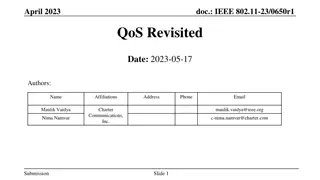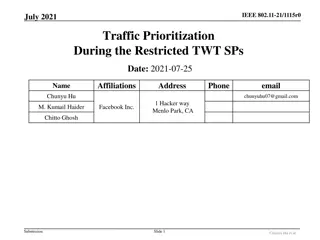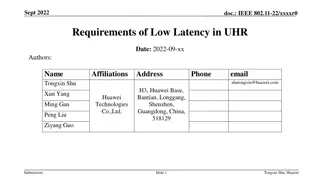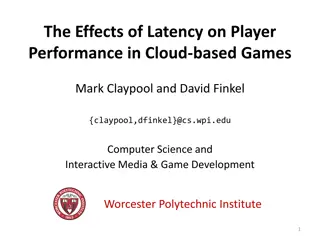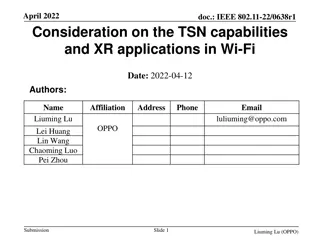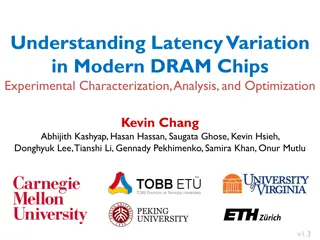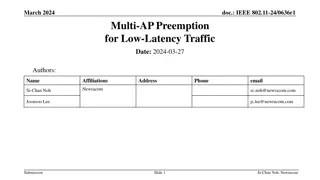Enhancing Channel Access for Latency-Sensitive Traffic in January 2022
In the documentation IEEE 802.11-21/0894r1, the focus is on improving channel access for latency-sensitive traffic through concepts like Restricted TWT (Target Wake Time). The proposal suggests methods to protect TWT Service Periods from non-TWT scheduled STAs, ensuring prioritized transmission of latency-sensitive data. Solutions are provided to handle scenarios where non-TWT STAs request transmission during TWT Service Periods. Discussions on handling RTS (Request to Send) and CTS (Clear to Send) messages from non-TWT scheduled STAs are also explored.
Download Presentation

Please find below an Image/Link to download the presentation.
The content on the website is provided AS IS for your information and personal use only. It may not be sold, licensed, or shared on other websites without obtaining consent from the author.If you encounter any issues during the download, it is possible that the publisher has removed the file from their server.
You are allowed to download the files provided on this website for personal or commercial use, subject to the condition that they are used lawfully. All files are the property of their respective owners.
The content on the website is provided AS IS for your information and personal use only. It may not be sold, licensed, or shared on other websites without obtaining consent from the author.
E N D
Presentation Transcript
January 2022 Channel Access for Latency Sensitive Traffic doc.: IEEE 802.11-21/0894r1 Date: 2021-05-18 Authors: Name Company Address Phone Email Liangxiao Xin Liangxiao.Xin@sony.com Mohamed Abouelseoud Mohamed.Abouelseoud@sony.com Li-Hsiang Sun Li-Hsiang.Sun@sony.com Sony Corporation Submission Slide 1 Liangxiao Xin, Sony
January 2022 doc.: IEEE 802.11-21/0894r1 Related Comments CID Commenter Clause Number(C) Comment Proposed Change Assignee 5880 Liangxiao Xin 35.6.4.1 Not every legacy STA will respect quiet element. More mechainsms other than quiet element is needed to enhance the medium access protection during a restricted TWT service period During a restricted TWT SP, the scheduling AP may not respond to a RTS whose TXOP overlapps with a R- TWT SP from a STA which is not a member of the restricted TWT. Chunyu Hu Submission Slide 2 Liangxiao Xin, Sony
January 2022 doc.: IEEE 802.11-21/0894r1 Introduction The group has agreed on using R-TWT and quiet interval to provide more predictable latency performance for latency sensitive traffic. During a R-TWT SP, R-TWT member STAs should be prioritized to transmit latency sensitive traffic. Other STAs may not enter quiet during R-TWT SP Quiet element is not implemented if device does not operate on DFS channel (e.g., U-NII) [1] Miss the latest update of the quiet interval (e.g., miss quiet element in beacon) It is optional for AP to schedule quiet interval during the first TU of the R-TWT SP EHT STAs may ignore the quiet element Other STAs will access channel during R-TWT SP and harm the latency performance of latency sensitive traffic. In this presentation, we discuss the channel access during the R-TWT SP to protect channel resource for latency sensitive traffic. Other tools are needed to protect R-TWT SP besides quiet interval. weak protection Submission Slide 3 Liangxiao Xin, Sony
January 2022 doc.: IEEE 802.11-21/0894r1 Network under consideration During the R-TWT SP, the STA can be classified as R-TWT scheduled STA (member or not member) support R-TWT operation Non-R-TWT scheduled STA We propose the methods to protect R-TWT SP from non-R-TWT scheduled STA R-TWT scheduling AP Non-R-TWT scheduled STA R-TWT scheduled STA, not member (Online/cloud gaming) R-TWT member STA (AR/VR) Submission Slide 4 Liangxiao Xin, Sony
January 2022 doc.: IEEE 802.11-21/0894r1 Proposed Solution 1 The R-TWT scheduling AP does not send an CTS in response to an RTS sent by non-R-TWT scheduled STA during a R-TWT SP. This solution could also apply to the R-TWT scheduled STAs that are not members AP does not send CTS R-TWT scheduling AP RTS Non-R-TWT scheduled STA R-TWT SP Open discussion: if non-R-TWT scheduled STA sends an RTS before the start of a R-TWT SP but the NAV duration of RTS overlaps that R-TWT SP, should R-TWT scheduling AP send CTS? Should AP send CTS? R-TWT SP R-TWT scheduling AP RTS Non-R-TWT scheduled STA NAV (RTS) However, pre-11ax STA makes its own decision of sending RTS or not. Submission Slide 5 Liangxiao Xin, Sony
January 2022 doc.: IEEE 802.11-21/0894r1 Proposed Solution 2 Giving R-TWT member STAs higher priority to access the channel during their R-TWT SP than other STAs The R-TWT scheduling AP and the member STAs contend the channel together during R-TWT SP. If a member STA obtain the TXOP first, let the R-TWT scheduling AP arrange the transmissions during TXOP The R-TWT scheduling AP collects the QoS requirement of the latency sensitive traffic of all the member STAs to allocate the channel resources to those STAs during TXOP. Benefits: Increase the chance of winning the competition with non-R-TWT scheduled STAs, not only those associated with the R-TWT scheduling AP but also those associated with OBSS AP. Reduce the channel contention delay for all the latency sensitive traffic Finish latency sensitive traffic transmissions of multiple STAs during one TXOP Help meet the QoS requirement of the latency sensitive traffic Submission Slide 6 Liangxiao Xin, Sony
January 2022 doc.: IEEE 802.11-21/0894r1 Example The R-TWT scheduling AP and member STAs contend the channel together during a R-TWT SP. the latency sensitive packets may arrive after the start time of R-TWT SP When a member STA (e.g., STA2) obtains TXOP during a R-TWT SP, it sends a frame (e.g., CTS frame) to share its TXOP with AP. The RA in CTS frame is set to a special address to indicate the TXOP sharing and NAV setting. The RA in CTS frame sent by any member STAs (e.g., STA1 and STA2) is the same. When AP receives the CTS frame or obtains the TXOP by itself, it takes over the TXOP and arranges the transmissions of all the member STAs. R-TWT SP AP arranges DL/UL/P2P transmissions during TXOP R-TWT scheduling AP STA2 obtains TXOP and shares it with AP Member STA1 CTS Member STA2 Submission Slide 7 Liangxiao Xin, Sony
January 2022 doc.: IEEE 802.11-21/0894r1 Conclusion R-TWT SP needs to be protected from the non-R-TWT STAs R-TWT scheduling AP can refuse to send CTS when receiving RTS from a non-R-TWT STA during R-TWT SP During R-TWT SP, R-TWT scheduling AP and member STAs should have higher priority to access the channel than other STAs. R-TWT scheduling AP and member STAs contend the channel together. When a member STA obtains the TXOP, let the R-TWT scheduling AP arrange the transmissions during TXOP Submission Slide 8 Liangxiao Xin, Sony
January 2022 doc.: IEEE 802.11-21/0894r1 SP1 Do you support that A R-TWT scheduling AP may not send a CTS in response to an RTS from a STA which is not a member of the R-TWT SP during a R-TWT SP? Note: this SP aims to trigger the below change in the spec for the resolution of CID 4121 10.3.2.9 CTS and DMG CTS procedure Change the below paragraph of this subclause: A VHT STA that is addressed by an RTS frame in a non-HT or non-HT duplicate PPDU that has a bandwidth signaling TA and that has the RXVECTOR parameter DYN_BANDWIDTH_IN_NON_HT equal to Static behaves as follows: If the NAV indicates idle, the STA is not NSTR limited and CCA has been idle for all secondary channels (secondary 20 MHz channel, secondary 40 MHz channel, and secondary 80 MHz channel) in the channel width indicated by the RTS frame s RXVECTOR parameter CH_BANDWIDTH_IN_NON_HT for a PIFS prior to the start of the RTS frame, then the STA shall respond with a CTS frame carried in a non-HT or non-HT duplicate PPDU after a SIFS. The CTS frame s TXVECTOR parameters CH_BANDWIDTH and CH_BANDWIDTH_IN_NON_HT shall be set to the same value as the RTS frame s RXVECTOR parameter CH_BANDWIDTH_IN_NON_HT. If all of the conditions in the previous paragraph are met, except for the condition the STA is not NSTR limited , then the STA may respond with the CTS frame as described in that paragraph. If the R-TWT scheduling AP receives a RTS frame during a R-TWT SP and the RTS frame is from a STA which is not a member STA of that R-TWT SP, then the AP may not respond with the CTS frame as described in that paragraph. Otherwise, the STA shall not respond with a CTS frame. Submission Slide 9 Liangxiao Xin, Sony
January 2022 doc.: IEEE 802.11-21/0894r1 SP2 Do you support that during a R-TWT SP, a member STA of the R-TWT SP can access the channel and share TXOP with the R-TWT scheduling AP? Note: this SP aims to trigger the below change in the spec for the resolution of CID 4121 35.8.4 Channel access rules for r-TWT service periods 35.8.4.1 TXOP rules for r-TWT SPs Add the below paragraph at the end of this subclause: A non-AP EHT STA with dot11RestrictedTWTOptionImplemented set to true may contend the channel during a R-TWT SP if that non-AP EHT STA is a member STA of that R-TWT SP. When the non-AP EHT STA accesses the channel, it may send a CTS frame to the R-TWT scheduling AP to share its TXOP. Submission Slide 10 Liangxiao Xin, Sony
January 2022 doc.: IEEE 802.11-21/0894r1 Reference [1] K nings, Bastian, et al. "Channel switch and quiet attack: New DoS attacks exploiting the 802.11 standard." 2009 IEEE 34th Conference on Local Computer Networks. IEEE, 2009. Submission Slide 11 Liangxiao Xin, Sony



